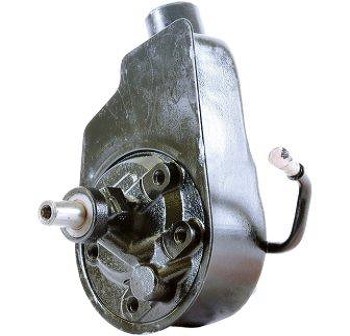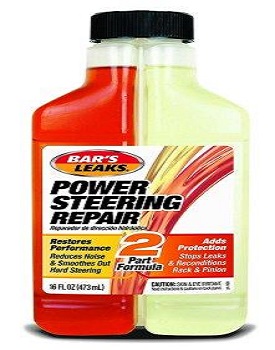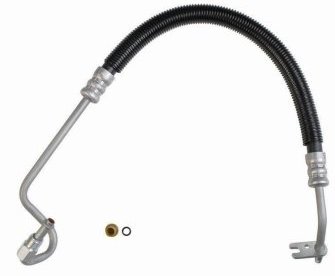Power Steering Noise Common Problems
A power steering noise sounds like a cross between a whine and a grinding noise. I'll provide a video just below this opening section that provides a textbook example of what a power steering pump noise sounds like.
Since the pump is a belt driven accessory it will only make noise when the engine is running. At idle the sound will seem consistent, but will increase in intensity when raising the engine RPMs.
However, the most distinguishing characteristic of a power steering noise is, the pitch will change when the steering wheel is moved from left to right.
This is because the internal pressure increases to move the front wheels in the desired direction. When the pressure increases it changes the sound dramatically.
Now we know the noise is coming from the PS pump, let's talk about what it will take to fix this common car problem.
In this brief article we'll cover why the pump makes noise and the most common cause of the issue. Next we'll talk about servicing the different parts that might fail in the power steering system.
Finally, we'll talk about using power steering stop leak and the different tools used when replacing the hydraulic pump.
 Power Steering Pump
Power Steering PumpWhy is the Power Steering Pump Noisy
The short answer to the question why the power steering pump makes these kinds of noises is the fluid level is low. In fact, the lower the fluid level the more noise it will make.
The technical reason is the impeller suffers from cavitation in the fluid. When the engine is running, the belt drives an impeller inside the pump.
They designed the impeller to be completely submerged in the hydraulic fluid. When the level decreases it pulls air into the fluid and turns the liquid into an air rated, foamy mess.
These tiny bubbles suspended in the fluid, reduce the quality of the hydraulic oil and the pump finds it difficult to produce the pressure needed to operate the steering system.
A lot of times people will see the power steering reservoir is low and add fluid thinking this will solve the problem.
In fact, it might solve the issue for the short-term. But the question is why the fluid became low in the first place.
Unfortunately, the answer is usually the fluid has leaked out. This means it will continue leaking and you'll find it necessary to add more fluid.
Using Power Steering Stop Leak Products
 Power Steering Repair Fluid
Power Steering Repair FluidIt's human nature to look for an easy way out of a common car problem.
Often automotive consumers will buy a bottle of power steering stop leak to solve the disappearing hydraulic oil. If you have visited other pages on this website you know I'm not a big fan of problem-solving fluids or additives.
With that said, there might be isolated situations where adding power steering stop leak could slow down the leak or solve it for good. However, I would equate the chances of this taking care of the issue with the chances of getting hit by lightning or winning the lottery.
Sure it could happen it's just not likely. Below we're going to get into
the specific problems that cause power steering leaks and their
solutions.
But we're going to skip ahead to talk about where and when a power steering stop leak product will work.
So let's talk a little about the types of leaking seals in the hydraulic pump itself. They connect the power steering pump to the fluid reservoir in most automotive applications over the last 30 years.
There are probably a half dozen rubber seals used throughout this assembly. The idea behind the stop leak product is that it softens and swells these rubber seals.
Therefore, if you have an O-ring seal that’s leaking because it has shrunk or become brittle over time, then the stop leak might help the situation.
However, if the leaking seal is one that’s under pressure then the likelihood of a leak sealing product working is slim to none.
Common Power Steering Problems
As a professional mechanic I can tell you that many possibilities exist to the root cause of your power steering problem.
With that said, there are a few common problems that I see much more often when it comes to low fluid situations.
On automobiles with hydraulic power steering you’ll have two main power steering lines running from the pump to the steering rack.
On really old cars you might find a steering box instead of a rack and pinion set up. These rubber and metal lines snake through the engine compartment.
One hose is called the pressure hose, because it carries the heavy load of pressurized fluid. The other line is considered a return line that brings back circulated fluid to the power steering reservoir.
It’s much more common for a pressurized line to leak than a return line. Nevertheless, there are many situations where I have found a leaking return line.
This is the best case scenario. In fact, if you get really lucky, maybe you will have a loose connection where the return line attaches to the reservoir.
Unfortunately, what I often find is the pressure hose will have rubber sections connected to metal lines with compression fittings.
The rubber lines are necessary to make flexible bends that allow the engine to move independently from the steering gear that is fixed permanently to the automobile.
Sometimes this constant movement can wear away at the rubber sections of the power steering pressure hose. Once they develop leaks there is no stop leak additive product in the world that will reverse the issue.
To solve the problem you’ll have to replace the power steering line. Although these parts aren't expensive, they are model specific and therefore prices will vary.
As far as the difficulty of replacing these components this will also vary. Some automobiles are difficult to get at the connection where it attaches to the power steering rack or steering box. In addition the flare nuts used in many applications are soft.
For this reason it’s recommended that you buy a line wrench designed for loosening these nuts. You can get a flare nut tool in the form of a socket they call a crow’s foot or crowfoot.
You can attach this to a long 3/8 extension with a universal joint. This provides the flexibility to loosen flare nuts in almost impossible situations.
Dealing with a Bad Power Steering Pump
As I mentioned in the power steering stop leak section, it's possible the pump itself can develop leaking seals. In this situation you will have two options.
You could purchase an overhaul kit and replace all of the leaking rubber seals. The other option is to replace the pump.
I like the second option better and recommend a complete replacement for do-it-yourself mechanics. Power steering pumps aren't cheap, but many of them are available in rebuilt parts.
You always take a chance when you buy a reconditioned component. With that said, I've had greater success with a re-manufactured power steering pump than I have with re-manufactured alternators and starters.
Unfortunately, there's something that we're going to have to struggle with when we decide to replace the power steering pump in the driveway.
For some reason most manufacturers have decided to press the drive pulley onto the input shaft of the power steering pump.
They make special tools to remove the pulley from the old part and reinstall it on the new one. They make a universal style kit that costs under $20.
This type of kit can work in many situations. For me, I decided to invest in a $40 tool from OTC that makes the job easier. It does this through smart design. It requires less room so you can get it into tight situations.
The other feature that the OTC tool provides is a hole that you can slide a rod or bolt into. This lets you hold the pump steady while rotating the center removal bolt. This is a handy feature when you don’t have the luxury of an electric or air-powered impact tool.
No matter which type of removal tool you decide to go with I have one last tip to leave you with. A lot of times when these pullers fail it’s because the threads are under tremendous pressure.
The devices will bend or the threads will strip. My tip is to apply some anti-seize compound to the threads of your power steering puller tool. This will not only lubricate and make rotating easier you'll find that the tool lasts longer.
Final Thoughts about Power Steering Noise
The time to take action on a power steering noise is when you first hear it. When the pump is making noise the air rated fluid can cause internal damage to the most expensive part of the system.
It’s sad for me when I find it necessary to replace a power steering pump and find that the root cause of the failure is a small leak from the return line.
If you continuously run an automobile with a power steering pump that’s screaming, it could cost you more than if you identified the issue immediately.
Author bio : Mark is a retired ASE certified master technician, Chevrolet Professional Service Council member and the founder of FixMyOldRide.com. Watch the video on the about Mark the mechanic page to see his credentials, awards and certifications for yourself. Mark hand writes all of the articles on FixMyOldRide.com unless indicated otherwise.
